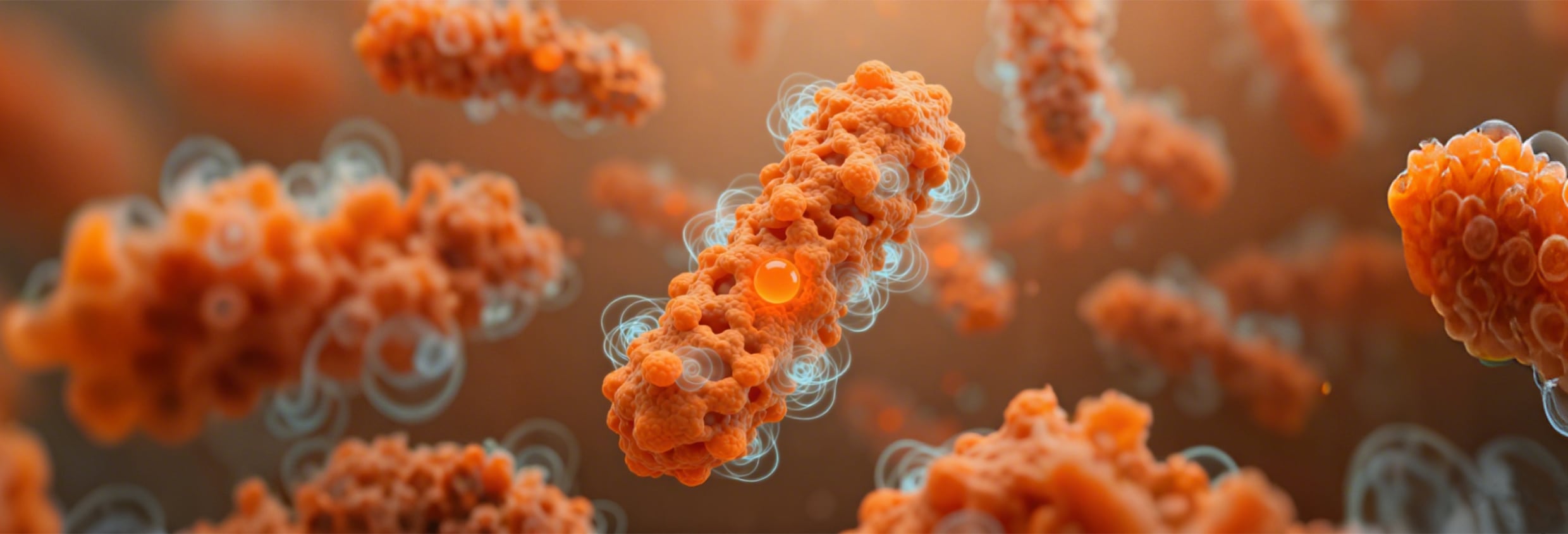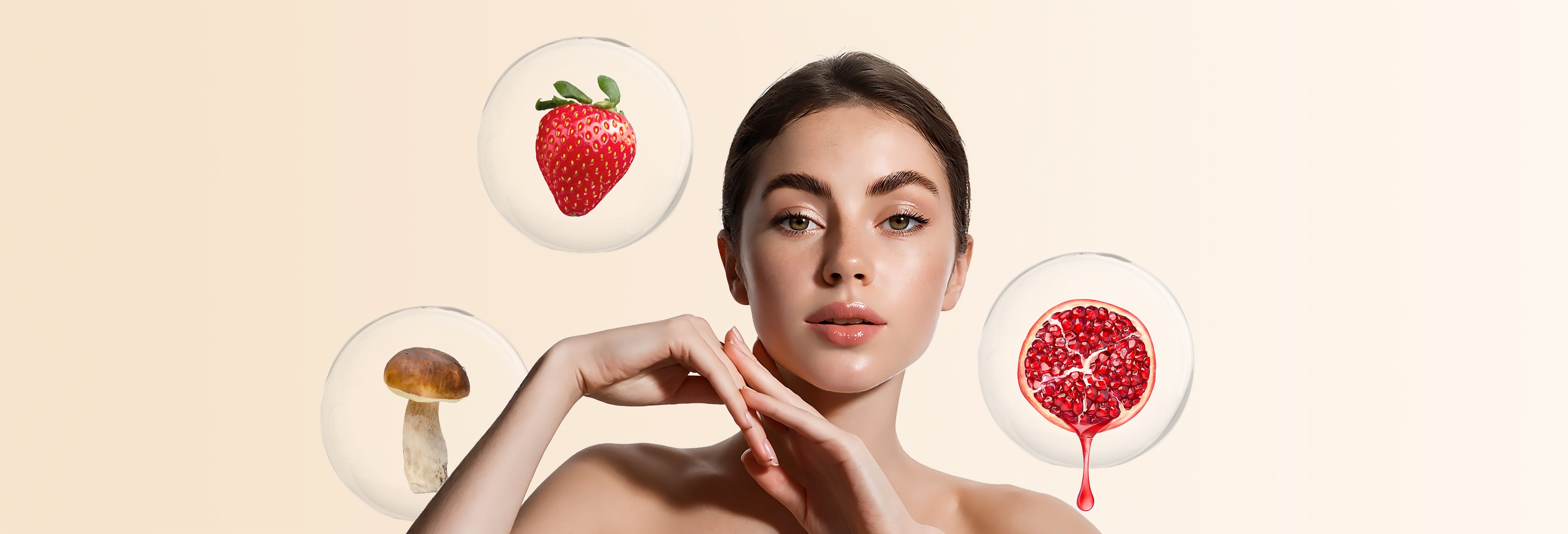A high-impact clinical study from Shanghai Jiao Tong University in 2025 has brought a gut bacterium called Akkermansia muciniphila (Akkermansia) into the spotlight.
Supplementing Akkermansia in individuals with low baseline gut Akkermansia levels not only helped Akkermansia successfully colonize the gut but also led to significant improvements in body weight, lipid profile, and even HbA1c, a key marker for long-term blood sugar control.
Touted as a ‘next-generation probiotic paradigm’, Akkermansia is naturally present in the human gut (1% to 5% of the microbiota) with beneficial effects on glucose and lipid metabolism as well as gut health.¹⁻² Currently, Akkermansia on the market comes as either live bacteria (probiotics) or pasteurized bacteria (postbiotics), with significant differences.
Live Akkermansia retains its reproductive capacity but faces numerous practical challenges:
- Safety concerns Akkermansia can degrade mucin, a key component of the intestinal barrier. Over-colonization may damage the mucus layer, potentially increasing the risk of colitis and colorectal cancer. In immunocompromised hosts, the abnormal proliferation of live bacteria can enhance the colonization of pathogenic bacteria, thereby worsening intestinal infections.³
- Reduced efficacy Live Akkermansia are prone to aggregation during formulation and storage. This leads to only a small number of cells surviving when they pass through the upper gastrointestinal tract to ultimately reach the intestinal mucus layer for colonization. More critically, even if Akkermansia reach the gut, the aggregated state can mask key functional proteins such as Amuc_1100 which are essential for interaction with intestinal target cells.
Live Akkermansia bacteria rapidly lose their viability upon exposure to oxygen. Additionally, they require refrigeration, are sensitive to stomach acid, and vulnerable to antibiotics, which limits their practical applicability.⁴
Pasteurized bacteria: Breaking limitations with potentially greater efficacy
Although pasteurized Akkermansia have lost their reproductive ability, the cell structure and active components are retained. Compared to live bacteria, its advantages are clear:
- More stable No cold chain needed; stable at room temperature, ensuring high concentrations reach the gut unaffected by environmental factors.
- Safer Cannot over-colonize the gut, avoiding microbial imbalance. Suitable even for the elderly and immunocompromised individuals.
- More flexible Can be used alongside antibiotics, even synergistically, overcoming the critical weakness of live bacteria.
A study in Nature Medicine showed that pasteurized Akkermansia was more effective than live Akkermansia in controlling body weight and reducing fat for mice on a high-fat diet:⁵
- Blood glucose control Pasteurized Akkermansia reduced fasting blood glucose by 29%, compared to only 18% with live bacteria.
- Fat reduction Pasteurized Akkermansia reduced subcutaneous fat by 34% and mesenteric fat by 37%, versus only 32% and 25% with live bacteria.
- GLP-1 increase Pasteurized Akkermansia increased GLP-1 level by 236%, which is four times the increase seen with live bacteria.
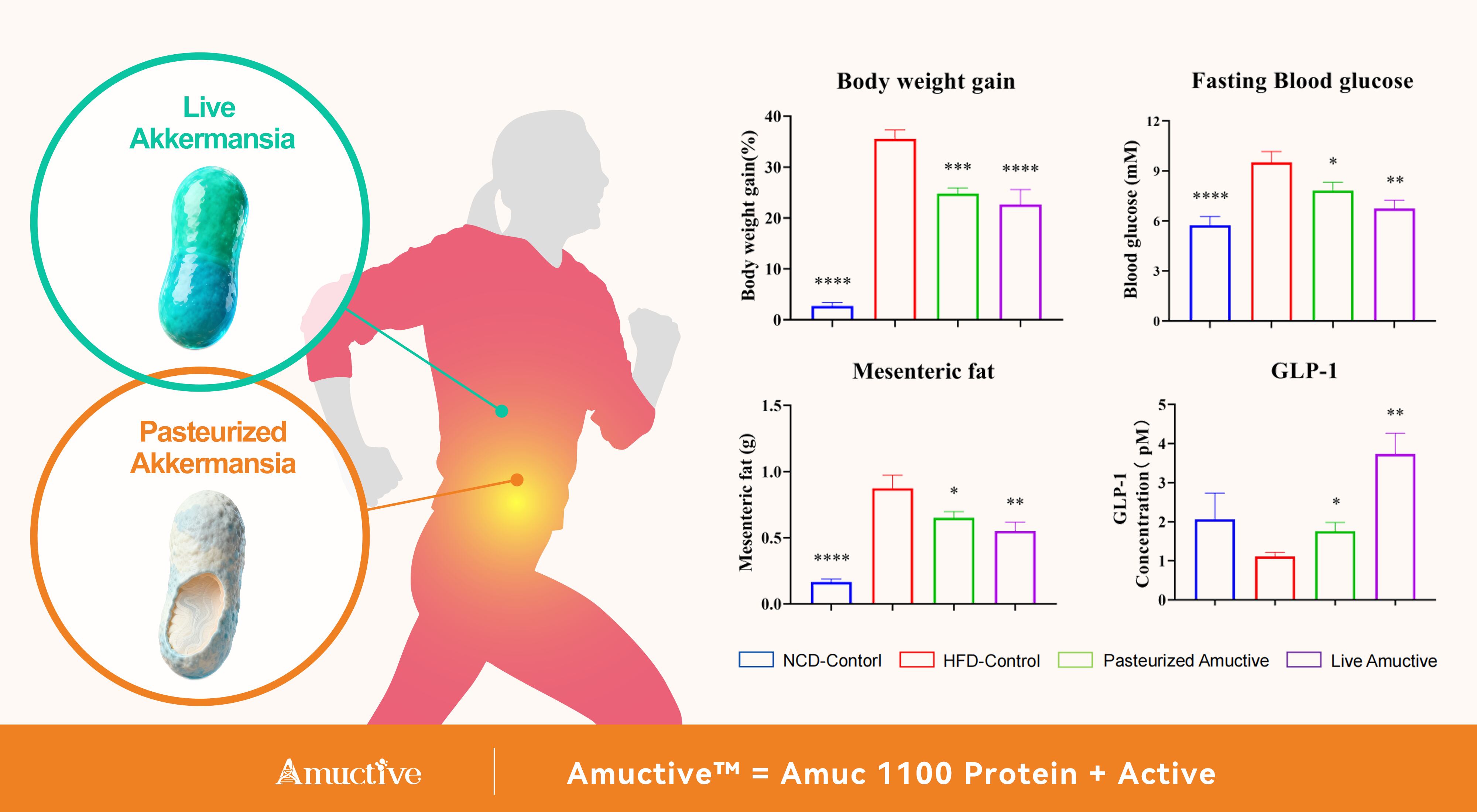
The core truth: Efficacy of pasteurized Akkermansia relies on Amuc_1100 protein
Why is pasteurized Akkermansia more effective than the live alternative? The answer lies in Akkermansia’s activity code – the Amuc_1100 protein.
Amuc_1100 is the most abundant pilus-like protein on the outer membrane of Akkermansia. It is not only robust (melting temperature 70°C, remaining active after pasteurization) but also acts as the engine for all its health benefits:⁵
- Supports immune function Binds to toll-like receptor 2 (TLR2) on human cells, activating signaling pathways that help build the gut’s defense wall and enhance anti-pathogen ability.⁵
- Regulates glucose and lipid metabolism Activates the AC3/PKA/HSL pathway, promoting fat breakdown and browning, reducing the risk of metabolic diseases like obesity and diabetes.⁶
- Downregulates inflammatory factors Inhibits the NF-κB inflammatory pathway, reducing pro-inflammatory cytokines like TNF-α and IL-6, alleviating systemic inflammation.⁷
- Protects gut barrier Activates cAMP-Responsive Element-Binding Protein H (CREBH) and TLR2, improving gut inflammation and enhancing barrier function, preventing harmful substances from entering the body.⁸
- Improves mood and cognition On one hand, Amuc_1100 can modulate the serotonin pathway to alleviate anxiety and depression; on the other, it improves age-related cognitive impairment via L-arginine metabolism.⁹⁻¹⁰
Simply put, without the Amuc_1100 protein, Akkermansia are just empty shells.
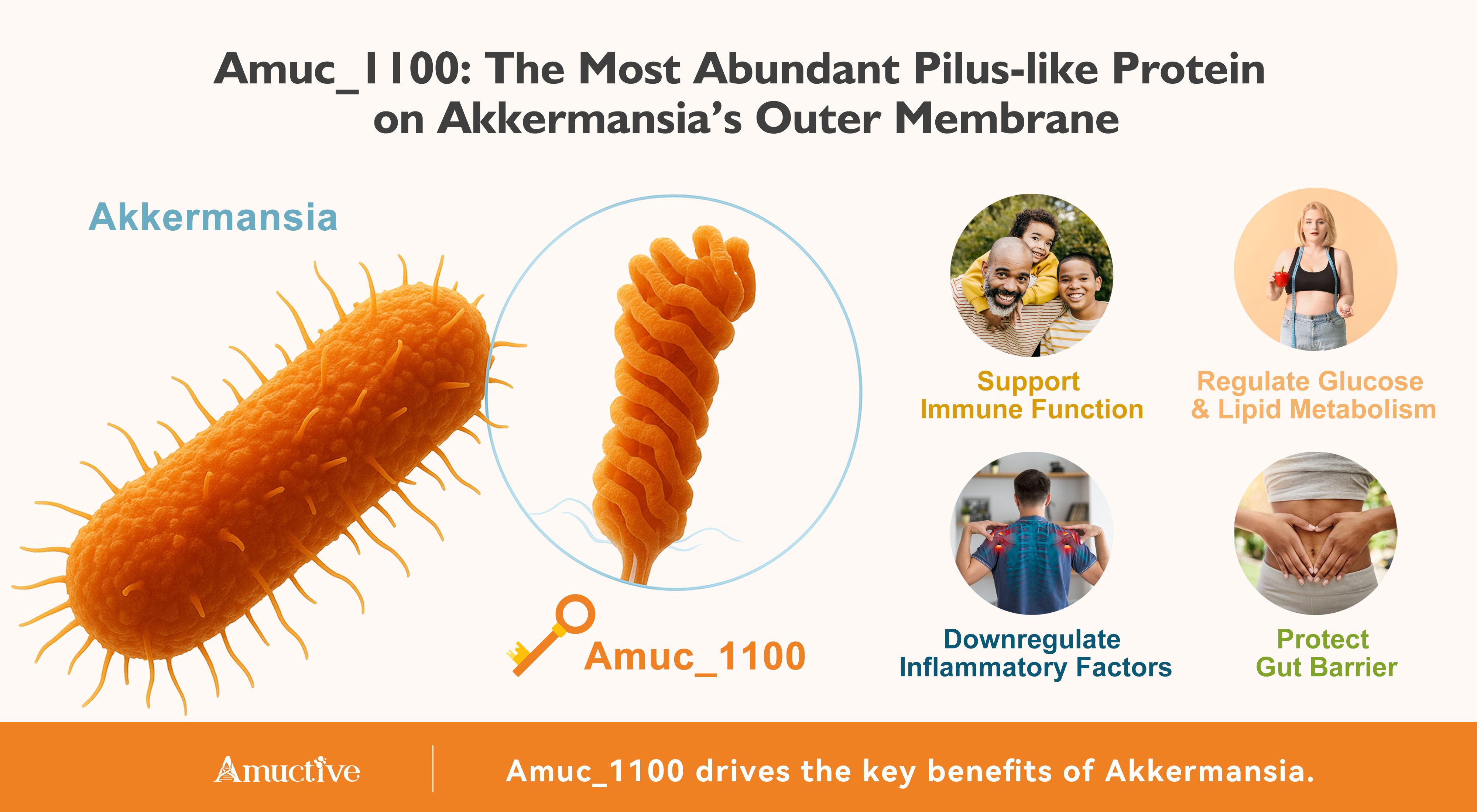
Why developing ‘second-generation Akkermansia’ was essential
Since Amuc_1100 is the key, do Akkermansia products on the market label the content of this protein?
The answer is: Most products only advertise ‘contains Akkermansia’ or ‘high total colony count’, but remain silent on the specific Amuc_1100 content. Even in the raw material’s Certificate of Analysis (COA), quality indicators related to active protein are often missing.
This is the fatal flaw of first-generation Akkermansia: focusing only on bacterial count while ignoring efficacy. You might think you’re supplementing with Akkermansia, but you might just be taking inactive bacterial shells, leading to no effect.
This is precisely why the development of second-generation Akkermansia became inevitable: it was necessary to go beyond the colony count trap and focus directly on the core active component, Amuc_1100, to truly deliver Akkermansia’s health benefits.
Second-generation Akkermansia: Redefining high-quality Akkermansia
Bonerge, in collaboration with the leading live biotherapeutic products company, Moon Biotech, has focused on deeply exploring the health value of Akkermansia, continuously investing in scientific research and optimizing processes and quality control specifically for the key active protein Amuc_1100.
After years of R&D, it launched the second-generation of Akkermansia – Amuctive™ (Amuc + Active, focusing on Akkermansia’s core active component, the Amuc_1100 protein) to the global market, officially ushering in a new era for Akkermansia from competing on bacterial count to emphasizing active potency.
1. Maximized activity: Patent-pending production method
Using a proprietary fermentation process, the content of Amuc_1100 protein in the Amuctive is significantly increased. Verified by proprietary detection technology, the Amuc_1100 content in Amuctive is 2.5 to 7.6 times higher than in other Akkermansia products.
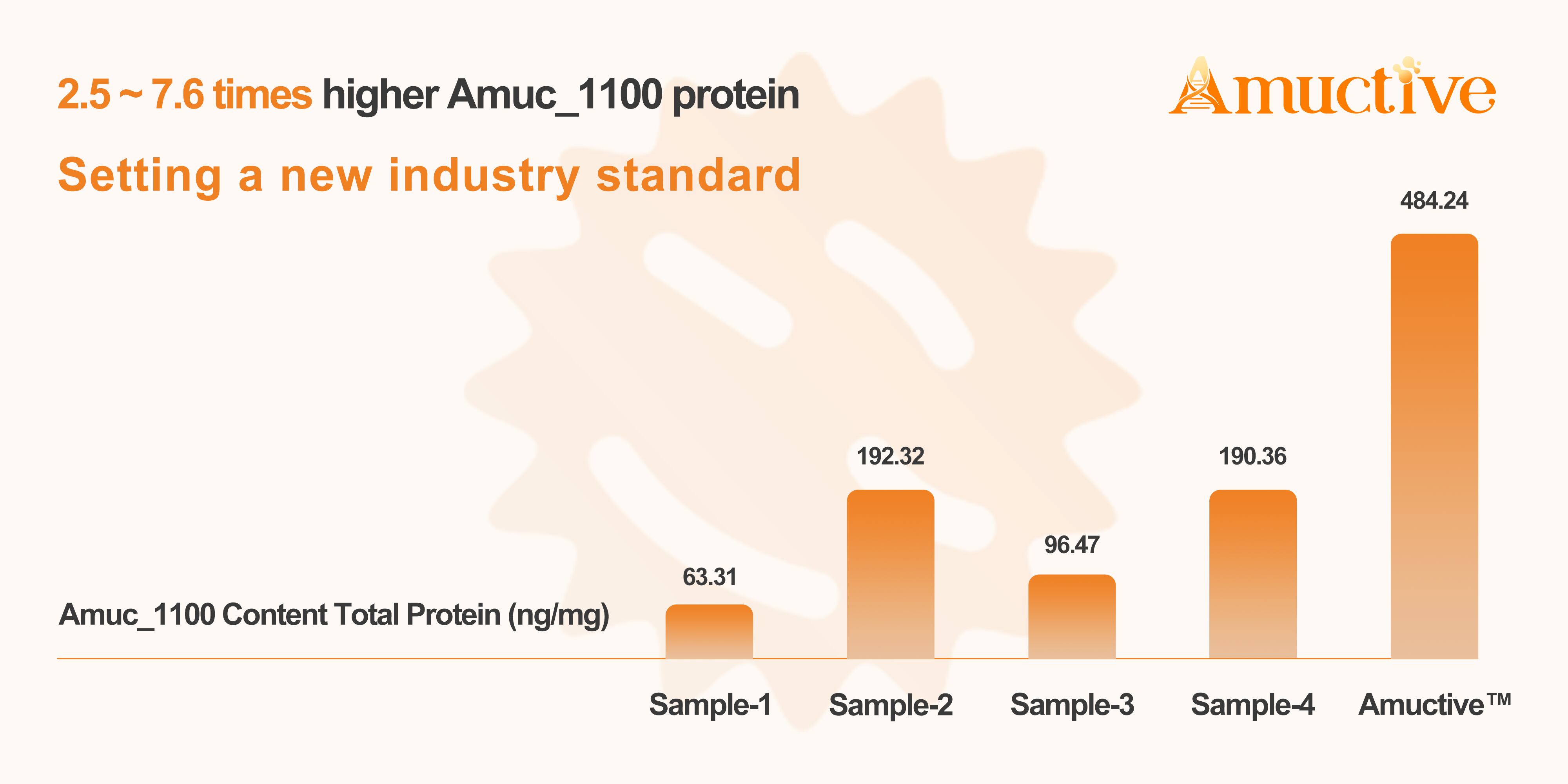
2. Controllable quality: Patent-pending method for precise measurement
Independently developed proprietary detection technology allows for accurate measurement of the specific Amuc_1100 content, enabling full quality control from production to finished product, completely avoiding the pitfall of only containing bacteria, but no activity.
3. Safe and effective: Dual assurance
- Authoritative certification SA-GRAS certified
- Patent portfolio Pioneered the filing of 10+ patents worldwide, three of which have been granted, establishing a strong technological barrier.
- Efficacy validation Has independently completed multiple validations for GLP-1 secretion promotion, glucose/lipid metabolism regulation, and cognitive improvement. Human clinical trials targeting blood lipids are currently underway, which will provide solid evidence for both safety and effectiveness.
Showcasing quality ingredients at Supply Side Global
The core value of second-generation Akkermansia Amuctive lies in transforming invisible activity into tangible quality that is measurable, controllable, and verifiable. This is its unique advantage and reflects Bonerge’s uncompromising commitment to product quality.
At the upcoming SupplySide Global 2025, Bonerge will showcase Amuctive and its other high-quality innovative ingredients – including Fisetin, urolithin A, S-equol, L-ergothioneine, and PQQ – to fully demonstrate the company’s R&D strength in the field of healthspan.
As an innovative healthspan ingredient developer, Bonerge anchors operations in safety and efficacy, delivering end-to-end health solutions to partners.
Join Bonerge at SupplySide Global 2025 (Booth 4331-1) to jointly create high-value health products for more people.
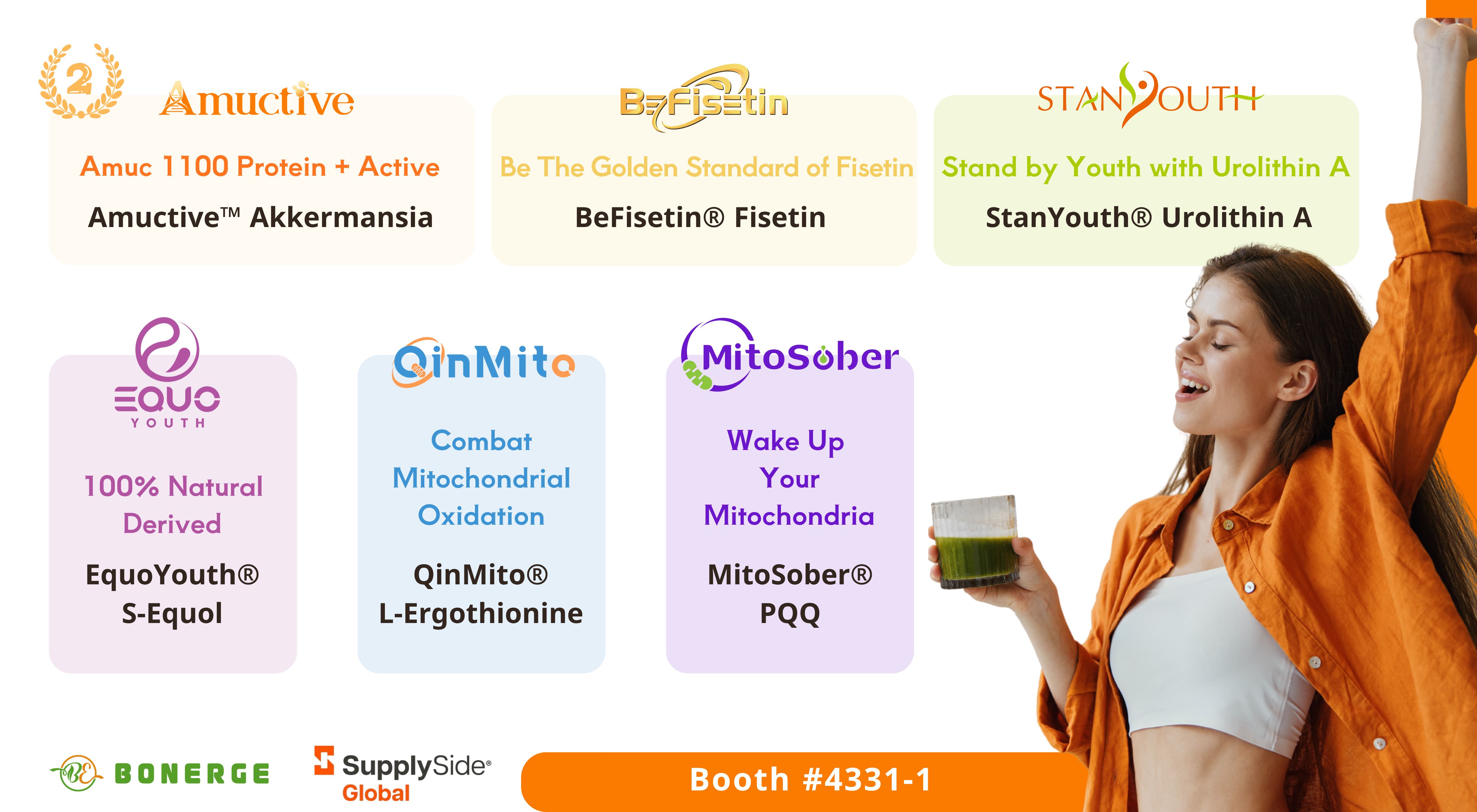
References
- Derrien, M.; et al. The Mucin degrader Akkermansia muciniphila is an abundant resident of the human intestinal tract. Applied and environmental microbiology. 2008; 74(5): 1646-8.
- Collado, M.C.; et al. Intestinal integrity and Akkermansia muciniphila, a mucin-degrading member of the intestinal microbiota present in infants, adults, and the elderly. Applied and environmental microbiology. 2007; 73(23): 7767-70.
- Wang, W.; et al. ILC3s regulate the gut microbiota via host intestinal galactosylation to limit pathogen infection in mice. Nature microbiology. 2025; 10(3): 654-66.
- Barbosa, J.C.; et al. Spray-Drying Encapsulation of the Live Biotherapeutic Candidate Akkermansia muciniphila DSM 22959 to Survive Aerobic Storage. Pharmaceuticals (Basel, Switzerland). 2022; 15(5).
- Plovier, H.; et al. A purified membrane protein from Akkermansia muciniphila or the pasteurized bacterium improves metabolism in obese and diabetic mice. Nature medicine. 2017; 23(1): 107-13.
- Zheng, X.; et al. Membrane Protein Amuc_1100 Derived from Akkermansia muciniphila Facilitates Lipolysis and Browning via Activating the AC3/PKA/HSL Pathway. Microbiology spectrum. 2023; 11(2): e0432322.
- Wang, L.J.; et al. Amuc_1100 pretreatment alleviates acute pancreatitis in a mouse model through regulating gut microbiota and inhibiting inflammatory infiltration. Acta pharmacologica Sinica. 2024; 45(3): 570-80.
- Wade, H.; et al. Akkermansia muciniphila and its membrane protein ameliorates intestinal inflammatory stress and promotes epithelial wound healing via CREBH and miR-143/145. Journal of biomedical science. 2023; 30(1): 38.
- Cheng R, et al. The modified outer membrane protein Amuc_1100 of Akkermansia muciniphila improves chronic stress-induced anxiety and depression-like behavior in mice. Food & function. 2022; 13(20): 10748-58.
- 10. He, J.; et al. L-arginine metabolism ameliorates age-related cognitive impairment by Amuc_1100-mediated gut homeostasis maintaining. Aging cell. 2024; 23(4): e14081.

